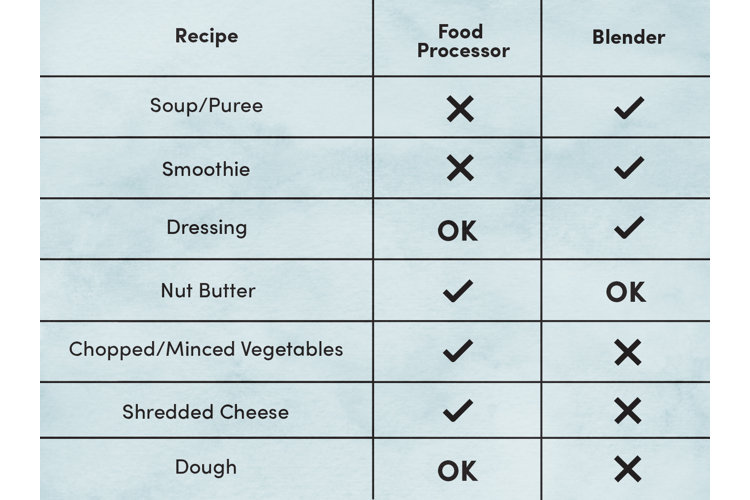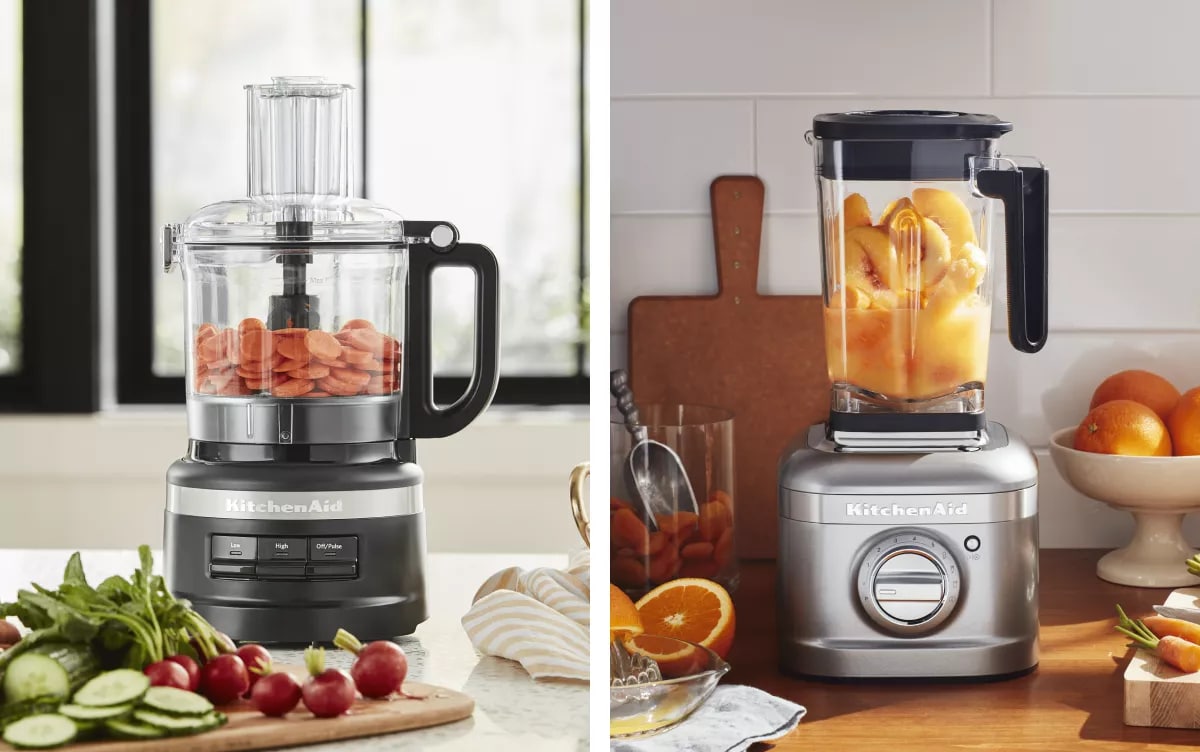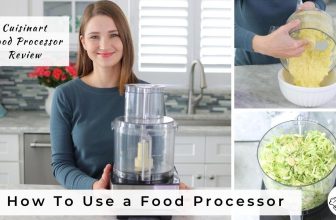Difference between Food Processor And Blender

Difference between Food Processor And Blender. A food processor is designed for chopping, slicing, and grating, while a blender is best for mixing and pureeing. Both appliances have distinct functions in the kitchen.
A food processor is ideal for preparing ingredients for recipes, while a blender excels at making smoothies, soups, and sauces. It’s important to understand the differences to choose the right tool for the task at hand. By knowing their unique capabilities, you can maximize the efficiency and versatility of these kitchen appliances.
Whether you’re a culinary enthusiast or a professional chef, having a good understanding of the distinctions between a food processor and a blender can significantly enhance your cooking experience. Let’s delve into the specifics of each appliance to grasp their individual strengths and applications.
Introduction To Kitchen Helpers
Discover the distinction between a food processor and a blender, two essential kitchen helpers. A food processor excels in chopping and shredding, while a blender is ideal for blending liquids and making smoothies. Each serves a unique purpose in the culinary world.
| Food Processor | Blender |
| Used for chopping, slicing, and shredding. | Primarily for blending, and pureeing liquids. |
| Has various attachments for different tasks. | Mainly has a pitcher with rotating blades. |
| Perfect for making dough and mixing. | Great for smoothies, soups, and drinks. |

Historical Evolution
| The evolution of kitchen appliances has come a long way. Early kitchen appliances were basic and served basic functions. The first food processor was invented in the 1960s by Pierre Verdon, a French catering company salesman. The blender, on the other hand, was invented in 1922 by Stephen Poplawski, a Polish-American bartender.
Over time, technological advancements have transformed both appliances. Food processors are designed to chop, grind, puree, and knead dough. They come with various attachments that allow for versatility in preparing food. Blenders, on the other hand, are designed to blend and mix ingredients, making them perfect for smoothies, milkshakes, and soups. While both appliances serve different purposes, they are essential in any kitchen. Understanding the difference between a food processor and a blender is key to making the right choice for your cooking needs. |
Food Processor Fundamentals
The main difference between a food processor and a blender lies in their functionality. While a blender is best for liquids and making smoothies, a food processor is more versatile and suitable for tasks like chopping, shredding, and slicing solid food ingredients.
Both appliances have their unique uses in the kitchen.
| Key Features | Common Uses |
| Multiple attachments for various functions | Chopping, slicing, and shredding vegetables |
| Large capacity for mixing dough and batters | Making purees and dips |
| Powerful motor for tough ingredients | Mixing and blending liquids and soft foods |
| Sharp blades for precise cutting | Creating smoothies and milkshakes |

Blender Basics
Blenders and food processors are both kitchen appliances but have distinct differences. A blender is ideal for mixing liquids, making smoothies or pureeing soft foods. In contrast, a food processor is better suited for slicing, grating, and chopping vegetables. Understanding the difference will help you choose the right appliance for your cooking needs.
| Food Processor | Blender |
| Designed for chopping, slicing, and grating. | Primarily used for mixing, pureeing, and blending. |
| Has various attachments for different functions. | Consists of a rotating blade at the bottom. |
| Great for making dough, shredding cheese, and slicing vegetables. | Ideal for making smoothies, soups, and sauces. |
Comparative Analysis
Discover the contrasting features between a food processor and a blender through a comparative analysis. Uncover the distinctions in functionality, versatility, and food preparation capabilities of these two kitchen appliances.
| Food Processor | Blender |
| Efficient at slicing, dicing, and shredding ingredients. | Great for mixing liquids and making smoothies. |
| Can handle heavier and thicker mixtures. | Ideal for blending fruits and vegetables. |
Making The Right Choice
Food processors and blenders may seem similar, but they have distinct differences. While blenders are best for liquids and creating smooth textures, food processors excel in chopping, slicing, and shredding solid ingredients. Understanding their unique features will help you make the right choice for your culinary needs.
| Food Processor | Blender |
|---|---|
| Best suited for slicing, shredding, and chopping solid foods. | Best suited for blending liquids, pureeing foods, and making smoothies. |
| Comes with a range of attachments for various functions. | Comes with blades for blending and crushing. |
| Can handle heavier and thicker mixtures and doughs. | Can handle liquids and soft foods better than solid foods. |
When choosing between a food processor and a blender, it is important to consider your kitchen needs. If you frequently need to chop vegetables or shred cheese, a food processor may be the better choice. However, if you prefer making smoothies or pureeing soups, a blender may be more suitable. Another factor to consider is the price versus functionality. A food processor tends to be more expensive than a blender, but it often comes with a wider range of attachments and can handle heavier mixtures and doughs. Ultimately, the choice between a food processor and a blender depends on your specific cooking and blending needs.
Care And Maintenance
|
|

Innovative Recipes
Food processors are great for making sauces, dips, and purees.
Blenders are perfect for smoothies, soups, and milkshakes.
Food processors chop, slice, and shred ingredients with ease.
Blenders blend, mix, and liquefy ingredients quickly and smoothly.
Expert Opinions
Discover the expert opinions on the key differences between food processors and blenders. Gain insights into their functionalities, performance, and versatility to make an informed decision for your kitchen needs.
| Expert Opinions |
| Chef Recommendations |
| Chefs recommend using food processors for chopping, grating, and slicing. They believe that food processors are perfect for preparing dough, making nut butter, and grinding meat. On the other hand, chefs suggest using blenders for pureeing, blending, and mixing liquids. They claim that blenders are excellent for making smoothies, soups, and sauces. |
| User Reviews and Ratings |
| According to user reviews, food processors are more versatile and can perform a variety of tasks. Users love that they can knead dough, chop vegetables, and grate cheese with ease. However, some users find that food processors are bulky and difficult to clean. On the other hand, blender users appreciate the smooth texture that blenders can create in purees and smoothies. They also like that blenders are easy to clean. However, some users complain that blenders are not as versatile as food processors. |
Future Of Food Preparation
The future of food preparation is evolving with advanced kitchen appliances like food processors and blenders. While a food processor is ideal for chopping, slicing, and shredding, a blender is designed for mixing and pureeing. Understanding the difference between the two can enhance cooking experiences and lead to delicious culinary creations.
| A food processor is great for chopping and slicing. | A blender is ideal for making smoothies and soups. |
| Food processors have more attachments for various tasks. | Blenders are more straightforward to use. |
| Emerging technologies focus on automation and convenience. | Smart features like app integration are becoming popular. |
| Future kitchen trends include multifunctional appliances. | People are looking for efficiency and time-saving solutions. |
Frequently Asked Questions
What Is Better, A Blender Or A Food Processor?
Both have unique uses, but a blender is best for liquids and a food processor for solids.
Can I Use A Food Processor As A Blender?
Yes, you can use a food processor as a blender. Both appliances are designed to process food, but blenders are typically better for liquids and smoothies, while food processors are more versatile for chopping, grinding, and mixing solid ingredients. Make sure to check the instructions and capacity of your specific appliance.
Is It Worth Getting A Food Processor?
Yes, it is worth getting a food processor. It can save you time and effort in the kitchen. A food processor can chop, slice, shred, and blend ingredients quickly and efficiently. It can also help you make homemade sauces, dressings, and dough.
Investing in a food processor can enhance your cooking experience.
Can Food Processors Blend Ice?
Yes, food processors can blend ice effectively for making smoothies, frozen drinks, and other cold treats.
Conclusion
To sum up, understanding the difference between a food processor and a blender is crucial for efficient and successful meal preparation. While both appliances serve a purpose in the kitchen, their functionalities and capabilities differ significantly. A food processor excels at slicing, chopping, and shredding, while a blender is ideal for blending and pureeing ingredients.
By choosing the right tool for the task at hand, you can elevate your culinary skills and create delicious dishes with ease. So, make an informed decision based on your specific needs and culinary preferences.






